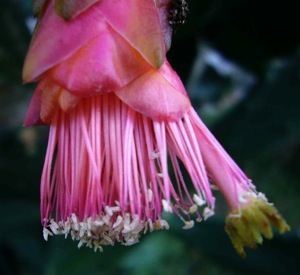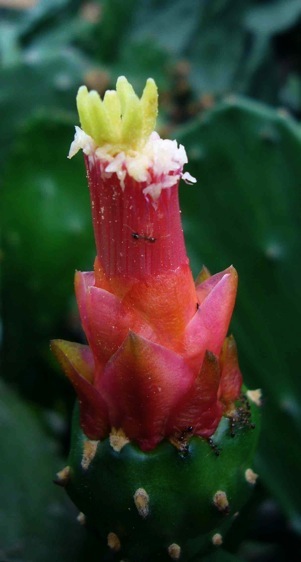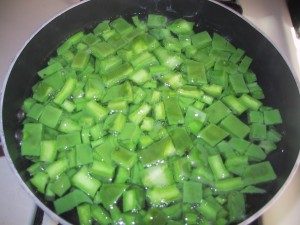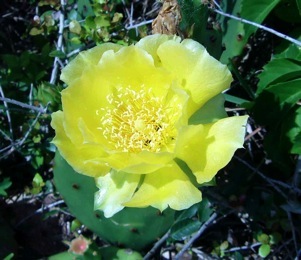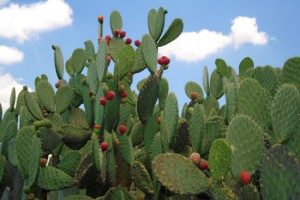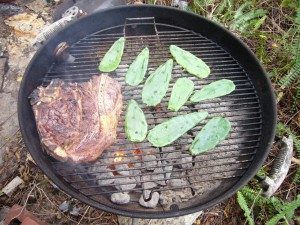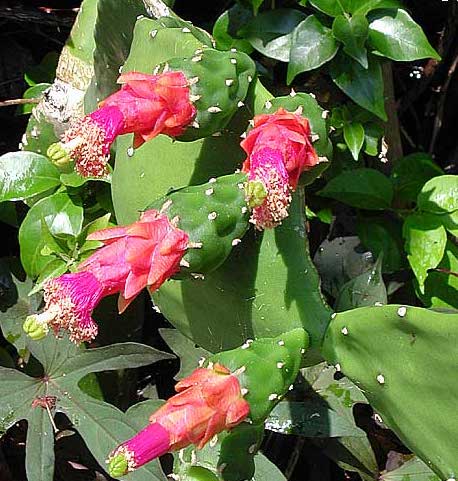
Nopales blossoms will turn to purple fruit. Photo by Green Deane
Nopalea Cochenillifera: Cactus Cuisine
Be brave when you collect cactus.
Of course, good gloves and tongs help. With those tools you can have a very steady and nutritious supply of a tasty wild edible, and not only in warm areas. Cactus grow from Alaska to Argentina, or chilly Canada to chilly Chili, and other parts of the world. People have been eating Nopalea/Opuntia for at least 9,000. It’s not too late to join them.
For example, Opuntia, the most common of the edible cactuses, is native to every U.S. state except Maine, New Hampshire, Vermont and Hawaii, the four states farthest from its native area, Central America (yes, Opuntia are native to southern Alaska and have become naturalized in Hawaii.) That said, I seem to remember seeing some growing in southern Maine in the woods when I was a kid, and I can remember the exact spot. So if not native, they did survive there. Some other families of cactus with edible members are Cereus, Hylocereus and Saguaro. There is probably an edible cactus near you. It also might be healthy: A close cousin, Opuntia Ficus-Indica, seems to have good effects on blood lipids. It also has antioxidants and might help in repair of DNA. O. ficus-indica is the cactus most often found for sale in stores.
Here in Florida there are several kinds of edible cactus. A very common one I have planted in my yard — but can be found growing wild everywhere — is Nopalea cochinellifera, (Noh-PAL–ee-uh koh-ken-ill-EE-fer-uh) also called the cochineal cactus. It was Opuntia cochinellifera (oh-PUN-she-ah koh-ken-ill-EE-fer-uh) but was given it own genus. It can grow in to a 12-foot tree-like cactus and requires much trimming to keep it in check. Both the fruit and the pads are edible after de-spining. Many references say the N. cochinillifera has no spines but they ar wrong. It has little tuffs stuffed with microscopic needles called glochines or glochids (best remove by a blast of water, and or burning off. Hot wax as last resort or duct tape.) “Glochis” is a Greek word meaning “the point of an arrow.” If you get one in your finger you’ll understand.
I got my Nopalea 19 years ago the true forager way. I was in Daytona Beach going to their annual Greek Festival. While walking on the sidewalk I saw one pad — technically a cladode. It had broken off a parent plant and lay on the walkway. I took it home, you know, be kind to homeless plants and all that. Now I have several N. cochinillifera and more cactus than the neighborhood can eat.
Besides food, the blossoms of the N. cochinillifera are a wonderful fuschia. They attract bees, butterflies and those rare little feathered helicopters, hummingbirds. The pear-shaped fruit are ripe when deep red to purple. A large cactus can have virtually hundreds of fruits
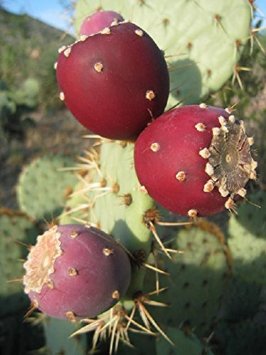
Fruit pulp tastes like raspberries.
Harvesting: The best thing to do is spray fruits and pads with water to reduce the amount of glochids. Pick the fruit with heavy leather gloves then wash them again and or burn what spines there might still remain off — a butane torch works well, a candle flame, or a deftly held propane torch. You then peel them for the soft red fruit flesh inside. It can be eaten raw or cooked and has a raspberry like flavor. Just be sure to take the seeds out. They are very hard and can break your teeth. Grind them into flour. I use often use the cactus fruit to make a salad dressing, especially when I am making a backyard salad. The pads are treated the same way, eat them as is or peeling them and eating the inner part of the pad, raw or cooked. Some say it is an acquired taste but I don’t think the flavor is that far out of the mainstream to say that. Besides everything other than mother’s milk is an acquired tasted. If you can get the spines off you can also eat the outer part of the pad. Just as the Nopalea has a history behind it so to does its name. Let’s take the species name first.
Cochenillifera in Latin means “cochineal bearing” but is from the Greek word for red, “kokinos.” That’s because the cochineal insect lives off that particular cactus and others in the family. That might be almost interesting except you may have eaten that exact insect at one time, or more specifically, a product produced from their crushed, little dehydrated bodies: Cochineal dye. Actually, only the female cochineal provides the red dye and it takes some 75,000 to make one pound, 155,000 to the kilogram. Sometimes in the wild you will see a Nopalea or Opuntia pad flecked with white gray, or even covered with white or gray cotton. That’s a cochineal condo. The hard part is each of the scale-like insects has to be harvested by hand, when they are around 90-days old.
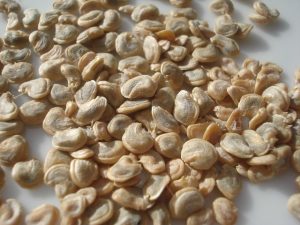
These cactus seeds are tough and need to be ground or roasted.
Until artificial dyes were invented, cochineal dye was the main red dye from food to fabrics. In the 1400s, eleven cities conquered by Montezuma each paid a yearly tribute of 2000 decorated cotton blankets and 40 bags of cochineal dye. During colonial days Mexico had a monopoly on cochineal dye and it was that country’s second largest export after silver. Cochineal went out of favor and flavor when chemical dyes came in but the organic movement and rejection of artificial dyes has brought it back. Cochineal trumps chemicals, as it were. If you use a cosmetic or have eaten a product with any of these ingredients, you have used or bitten the bug: Cochineal extract, carmine, crimson lake (or lac) natural red 4, C.I. 75470, E120, or even “natural coloring” when the product is any shade of red, scarlet or orange. Cochineal is one of the few water-soluble dyes that resist fading.
The genus name, “nopal” means cactus in Nahuatl, the language of the Aztecs, wrongly reported as “Spanish” for cactus. No, the Aztecs had the word first. Opuntia, however, is very removed from the New World. It is from a Greek word, Opos. Opos is an area near Lokria on the island of Euboea, which is northeast of Athens. The Greeks say the island’s name as EH-via (see how Latin has perverted the Greek it imported.) Evia is a favorite get away and one end of the island is only about 100 tidal-torn feet from the mainland. In the Opos area, according to Pliny and Theophrastus, there grew a spiny plant. There also grew figs. Figs are one of the few foods with a latex sap that we can eat (see Natal Plums.) That sap was used as rennet in making cheese. Rennet makes the solids in the milk separate from the liquids so it can be made into cheese. The adjective form of the opos is opuntios, meaning “of Opos.” It came to mean fig-shaped. The cactus, which has spines and a fig-shaped fruit (kind of) got named Opuntios. That was then degraded via Latin to Opuntia, and where I get linguistically irritated when it comes to English. The original word is Greek and is spelled with a T. The T is pronounced as a T, not an S. Yet when you say “oh-PUN-tia” there is always someone around who will try and correct you with “oh-PUN-see-ah.”
Incidentally that cheese-making technique was mentioned in the Iliad and later by Aristotle. It was used well into the 1800s until bacterial ways were found to curdle milk. The technique was so common it was mentioned in several farming “books” by ancient Greeks and Romans.
Opuntia littoralis was introduced to Mediterranean area long ago and flourishes in its mild climate, such as in the south of France, southern Italy, and Sicily where it is a culinary speciality called ficurinnia. In Greece the fruits are called frangosyka (French figs) or pavlosyka (Paul’s figs). The prickly pear also grows in Malta where it is a typical summer fruit and used to make the popular liqueur, Bajtra. There the opuntia is a common dividing wall between Maltese fields.
Nopalea is good for you. There is some lab evidence that it lessens low-density cholesterol, though not reported is whether that was large molecule LDL or small molecule LDL. It’s the small molecule LDL that harms (as of this writing.) The exact nutritional value is not set with several sources giving differing amounts. But, it is low in calories and sodium, high in fiber and vitamin C. It also helps control blood sugar and, according to lab work, reduces the effects of a hangover if eaten before drinking. One word of caution, besides avoiding the spines: Never eat any part of any cactus that has white sap.
Below are some recipes, though they are as common on the internet as spines on a cactus. One note of forecaution: Eating ripe opuntia fruits can turn ones urine reddish. Thought you’d like to know rather than it be a surprise. My two favorite ways of preparing Opuntia/Nopales pads is to pick young ones, brush off the glochids, julienne the pads, and fry in oil. Or, grill them and put them in a sandwich. Delicious. Of course, you can always skip the cactus collecting and give Nopales a try from the can or with commercially harvested pads. Both are found in many supermarkets these days. And let me be honest, I used to cheat a little. Many times when I was serving a dish of a “wild” food — to a group known to have a few squeamish people in it — I would actually buy the “wild” product in the local market, keeping the receipt. That way if someone said they got sick from the “wild” food it was 1) highly unlikely or 2) the grocer’s problem not mine.
Scrub cactus pads well, remove any spines. Cut around the spiny nodules and remove them, completely. (Not necessary with young thin pads. Use whole) Grill the leaves over charcoal for 10 to 12 minutes per side. Thicker pads take longer. Brush pads with oil occasionally while grilling. Serve hot.
Cactus Jelly
One to two quarts or so of cactus fruit (1.5 pounds)
3 cups sugar
1/2 cup lemon juice**
6 ounces liquid fruit pectin Boiling water
Cheesecloth
Place fruit in a large saucepan or kettle. Cover with boiling water, allow to stand for 2-3 minutes, and pour off water. (This aids in softening stickers of the fruit.) Peel fruit, cut into pieces, and place in a medium-sized saucepan. Cover fruit with water and boil at high heat for 5 minutes. Pour boiled mixture through cheesecloth. Drain as much juice as possible. Discard seeds. Measure juice. Combine cups of cactus juice, sugar , and lemon juice in large saucepan. Bring mixture to a rolling boil. Reduce heat to medium-high, add liquid pectin, and cook mixture for 8-12 minutes, or until the mixture begins to thicken. Skim off any foam that may have formed. Pour mixture into hot, sterilized, canning jars and seal as usual. Process jars immersed in a Boiling Water Bath for five minutes to seal the lids.
Cactus Monterey
1 pound cactus pieces
1 small tomato
1/4 small white onion
1 jalapeno pepper
1/4 bunch cilantro
1/4 cup shredded Monterrey jack cheese (or of choice)
1 teaspoon salt (optional)
4 tablespoons avocado or low heat olive oil
Steam the cactus until softened. Drain the cactus. Lightly fry all the other ingredients except for the Monterrey Cheese. Combine fried ingredients with the cactus and allow to simmer for 15 minutes. Top with cheese before serving.
CACTUS FLOWER WINE by Jack B. Keller, Jr.
- 2-1/2 quarts firmly-packed cactus flowers
- 2 lbs granulated sugar
- 1 11-oz can 100% white grape juice concentrate, frozen
- 1-3/4 tsp acid blend
- 1/8 tsp grape tannin
- 6-1/4 pints water
- 1 crushed Campden tablet
- 1 tsp yeast nutrient
- 1 pkt Champagne wine yeast
Wash the flowers and put in nylon straining bag with a dozen marbles for weight, tie bag, and place in primary. Heat 1 quart water and dissolve sugar. Cool with frozen grape juice concentrate and remaining water and add to primary. Add remaining ingredients except yeast and stir well. Cover primary and wait 10-12 hours before adding activated yeast. Recover primary and stir daily. When specific gravity drops to 1.020, drip-drain bag and transfer wine to secondary. Affix airlock and set aside. Rack after 45 days and again after another 45 days, topping up and refitting airlock each time. If fermentation has finished, wine should be clear or begin to clear, although pollen will continue to settle for another 1-2 months. Rack again 60 days after wine has cleared, top up and reattach airlock. Set aside another 90-120 days to bulk age. Stabilize, sweeten to taste and rack into bottles. May taste after 6 months in bottle.
Green Deane’s “Itemized” Plant Profile
IDENTIFICATION: Nopalea/Opuntia can usually be distinguished by flat, rounded pads that are actually jointed stems. They’re usually covered with two kinds of spines, fixed brittle needles and tiny glochids that stick to you instantly. Blossom vary greatly from bottle brush to rose-like. They are a large family, two genera, so learn your local varieties. Duct tape is good for glochid removal, or hot wax.
TIME OF YEAR: Blossoms in spring or summer in some climes, year round in others, pads edible year round, fruit in season.
ENVIRONMENT: They grow from northern Canada to southern South America, rainy Florida to dry deserts.
METHOD OF PREPARATION: Young pads are edible whole. Older pads are usually peeled or have spine eyes removed. The best pads are shiny and not too thick. They get fiberous then woody as they age. The inner flesh of the red fruit is edible having a flavor similar to raspberries. Juice from the inner fruit can be used as is or made into ade or jelly. The hard seeds must be ground before eating. The inner flesh of some pads of many if not most species is also edible, can be sour. If your cactus has milky sap. DON’T EAT IT. You’ve got the wrong plant.

